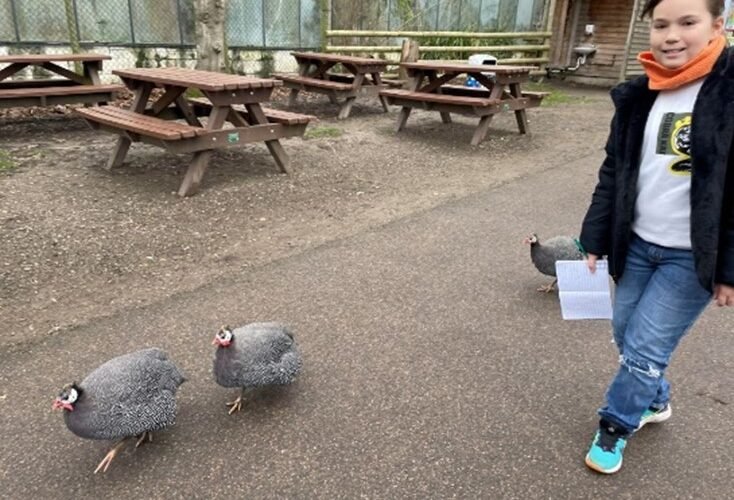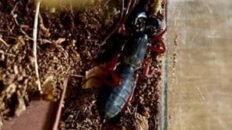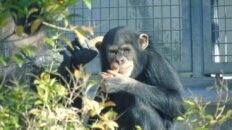Hi, it’s Celia again and I’m here with my second blog for Wingham Wildlife Park!
I visited the park on Thursday 28th December – Brrr (it was cold!).
I arrived after lunch as I wanted to listen to the Big Cat Talk at 2pm. Again, I will concentrate on just two areas of the park and this will be one of them.

The Reptile House
If you haven’t been to Wingham Wildlife Park for a little while you might not know that the Reptile House has undergone incredible refurbishment with larger enclosures for all the reptilian and amphibian species.
They have also welcomed nine new species including the Black and White Tegu, Standing’s Day Geckos and Common Sun Skinks.

It was extremely chilled in the Reptile House and very warm which was a nice break from the cold.
The Bearded Dragons were as still as statues, the Crocodile’s were bathing in the water, a snake lay nestled under a log and an Iguana was laying on the ground stretched out like a pancake!
Altogether, they were moving incredibly slow or not at all.
The Green Iguana
Did you know…
- Green Iguana’s vary in colour, their skin turns darker in the sun and lighter when it gets too hot or bright. Breeding males also turn orange or gold.
- An Iguana’s tail can drop off, it’s a natural process called autotomy. It means that the Iguana can get away if a predator grabs it by the tail. A new tail will grow back within a year – sometimes in just two or three months!
- The Green Iguana is also known as “Iguana Iguana”.


It was hard not to notice the considerable number of reptiles considered endangered and critically endangered. They are poached mainly for;
- Traditional medicine
- Decor
- Bushmeat
- Pet trade
You can find out more about this by reading the many posters scattered around the Reptile House. What I did learn from reading the information available is that quite often we blame the “poachers” who are mainly poor people trying to feed their families when in fact, more blame should lie with those who buy the pets, ivory, medicine etc.
George, Head of Primates wrote a blog about “Endangered Species Day” which is held annually on 19th May. If you want to find out more about this, click here.
The Big Cat Talk
I went to the Lion enclosure at 2pm to hear Rebecca talk about the Big Cats (this did not include the Tigers, so I will talk about them in my next blog).
Rebecca has worked at Wingham for just over a year (which is amazing really as she knows so much about the Big Cats and has a fantastic relationship with them).
Rebecca’s favourite Big Cat (although it was hard for her to choose) is the Tigers.
I asked Rebecca what the Big Cats eat which consists mainly of horse meat (these are pet horse’s that have passed away so they are not slaughtered specifically to feed them), chickens and rabbits.
The Lion – Clarence
Clarence turned 16 on Christmas Eve. He sadly lost his companion Brutus in November 2022.
Clarence and Brutus were rescued from a French Circus in 2011.
Clarence can not be bred because there are no genetics or family history.
Unfortunately, I couldn’t get a picture of Clarence because he was busily fighting with a bucket inside!
The Pumas – Binx and Lola
Binx
Binx was hand-raised as he was rejected by his mother. He is extremely friendly as you can see from the photo, Rebecca is able to stroke him like a domesticated cat.

Lola
Lola is reddish in colour and has smooth fur unlike Binx who is lighter in colour and has a fluffy coat. This is because Binx is from America and Lola is from South America.
The Jaguars – Loki and Luna
Rebecca explained that many people think Luna and Loki are different species and question why they are in the same enclosure as Luna appears jet black in colour. They are in fact both Jaguars. Luna has a condition called Melanism which is an unusual development of dark colour in the skin and is the opposite of albinism.
- Fact – the word “melanism” comes from the Greek for “black pigment”.
- Both Loki and Luna have rosettes but you would only see Luna’s if you looked very closely.
- Luna is 12 and Loki is 11.
Luna was too far away for me to get a good photo.


Did you know…
- Lions start off spotty. Young lions have rosettes and spots on their sandy coat, but these generally disappear as they mature.
- Pumas have a Guiness World Record for the most classified names. In the English language alone, it has over 40, including cougar, panther and mountain lion.
- Jaguars have the most powerful bite of all the world’s big cats!
Here are some of my favourite snaps:

If you read my last blog, you will have heard me talk about the Chimpanzees.
I couldn’t believe it when I found out that Tara and Fritz had had a baby in December this year!
I was so pleased to hear that Tara and her baby were doing brilliantly and even more pleased to be able to witness it for myself (I had to zoom in so the picture is a bit blurry).
This is amazing news as the Western Chimpanzees are critically endangered.
Is it a boy or a girl? – We still don’t know!






I had another fantastic trip to Wingham and have loved writing this blog so I hope you enjoy reading it.
Source: winghamwildlifepark.co.uk









 Please wait...
Please wait...

Add comment